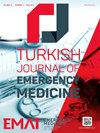第三波COVID-19大流行期间年轻患者的体外膜氧合经验:一项回顾性观察研究
IF 1.1
Q3 EMERGENCY MEDICINE
引用次数: 1
摘要
目的:本文介绍了重症监护病房(ICU)年轻患者数量增加的第三波重症肺炎(COVID-19)病例后3个月内体外膜氧合(ECMO)支持的结果。方法:经卫生部科研平台同意并经当地伦理委员会批准,在我院三级转诊医院ICU接受ECMO支持的所有COVID-19患者进行研究。患者资料回顾性地从重症监护床边随访图表和计算机记录中获得。患者的人口学和临床特征以平均值、中位数和百分比表示。对患者资料进行评估,并与现有文献进行比较。结果:最近3个月随访的7例重症COVID-19肺炎患者均采用ECMO治疗。所有患者均行静脉-静脉体外膜氧合(VV-ECMO)。7例患者中有5例(71.5%)脱离ECMO。7例患者中4例(57.2%)健康出院。其中2例患者在ECMO前进行了剖宫产(C/S), 1例患者在ECMO下进行了C/S。所有三名新生儿均通过C/S分娩,均为早产儿(C/S日期分别为35周、32周和27周),均健康出院。结论:我们的经验表明,ECMO在COVID-19患者中是一种挽救生命的治疗选择,可以成功应用于常规治疗无效的严重急性呼吸窘迫综合征病例。本文章由计算机程序翻译,如有差异,请以英文原文为准。
Extracorporeal membrane oxygenation experiences during COVID-19 pandemic, third wave with younger patients: A retrospective observational study
OBJECTIVES: In this article, the results of severe coronavirus disease 2019 (COVID-19) cases followed with extracorporeal membrane oxygenation (ECMO) support in a 3-month period in the third wave when there were an increased number of cases of young patients in our intensive care unit (ICU) were presented. METHODS: The study was carried out with all COVID-19 patients who were given ECMO support in our tertiary referral hospital ICU after obtaining the consent of the Ministry of Health Scientific Research Platform and after the approval of the local ethics committee. Patient data were obtained retrospectively from intensive care bedside follow-up charts and computer records. The demographic and clinical characteristics of the patients were presented in average, median, and percentages. The data of the patients were evaluated and compared with the current literature. RESULTS: ECMO treatment was applied in seven patients who were followed up with severe COVID-19 pneumonia in the last 3 months. Venovenous extracorporeal membrane oxygenation (VV-ECMO) was applied to all patients. Five (71.5%) of seven patients were weaned from ECMO. Four (57.2%) of seven patients were discharged from the ICU and hospital in good health. While two of the patients had a cesarean section (C/S) before ECMO, one patient underwent C/S under ECMO. All three newborns were delivered via C/S and all were premature (C/S dates were 35 weeks, 32 weeks, and 27 weeks), and all were discharged from the hospital in good health. CONCLUSION: Our experience shows that ECMO in COVID-19 patients is a lifesaving treatment option that can be successfully applied in severe acute respiratory distress syndrome cases who do not respond to conventional treatments.
求助全文
通过发布文献求助,成功后即可免费获取论文全文。
去求助
来源期刊

Turkish Journal of Emergency Medicine
EMERGENCY MEDICINE-
CiteScore
1.70
自引率
0.00%
发文量
30
审稿时长
22 weeks
期刊介绍:
The Turkish Journal of Emergency Medicine (Turk J Emerg Med) is an International, peer-reviewed, open-access journal that publishes clinical and experimental trials, case reports, invited reviews, case images, letters to the Editor, and interesting research conducted in all fields of Emergency Medicine. The Journal is the official scientific publication of the Emergency Medicine Association of Turkey (EMAT) and is printed four times a year, in January, April, July and October. The language of the journal is English. The Journal is based on independent and unbiased double-blinded peer-reviewed principles. Only unpublished papers that are not under review for publication elsewhere can be submitted. The authors are responsible for the scientific content of the material to be published. The Turkish Journal of Emergency Medicine reserves the right to request any research materials on which the paper is based. The Editorial Board of the Turkish Journal of Emergency Medicine and the Publisher adheres to the principles of the International Council of Medical Journal Editors, the World Association of Medical Editors, the Council of Science Editors, the Committee on Publication Ethics, the US National Library of Medicine, the US Office of Research Integrity, the European Association of Science Editors, and the International Society of Managing and Technical Editors.
 求助内容:
求助内容: 应助结果提醒方式:
应助结果提醒方式:


